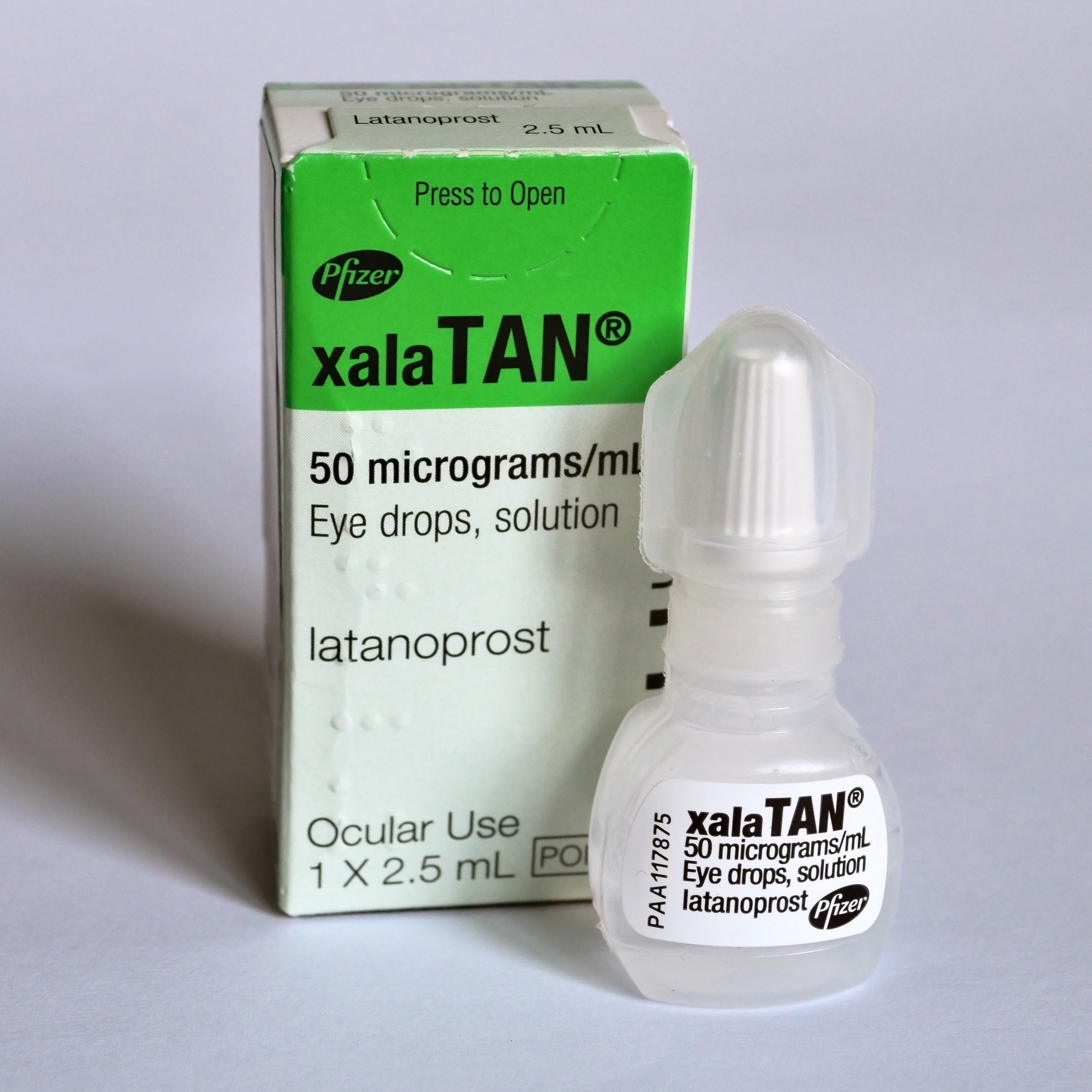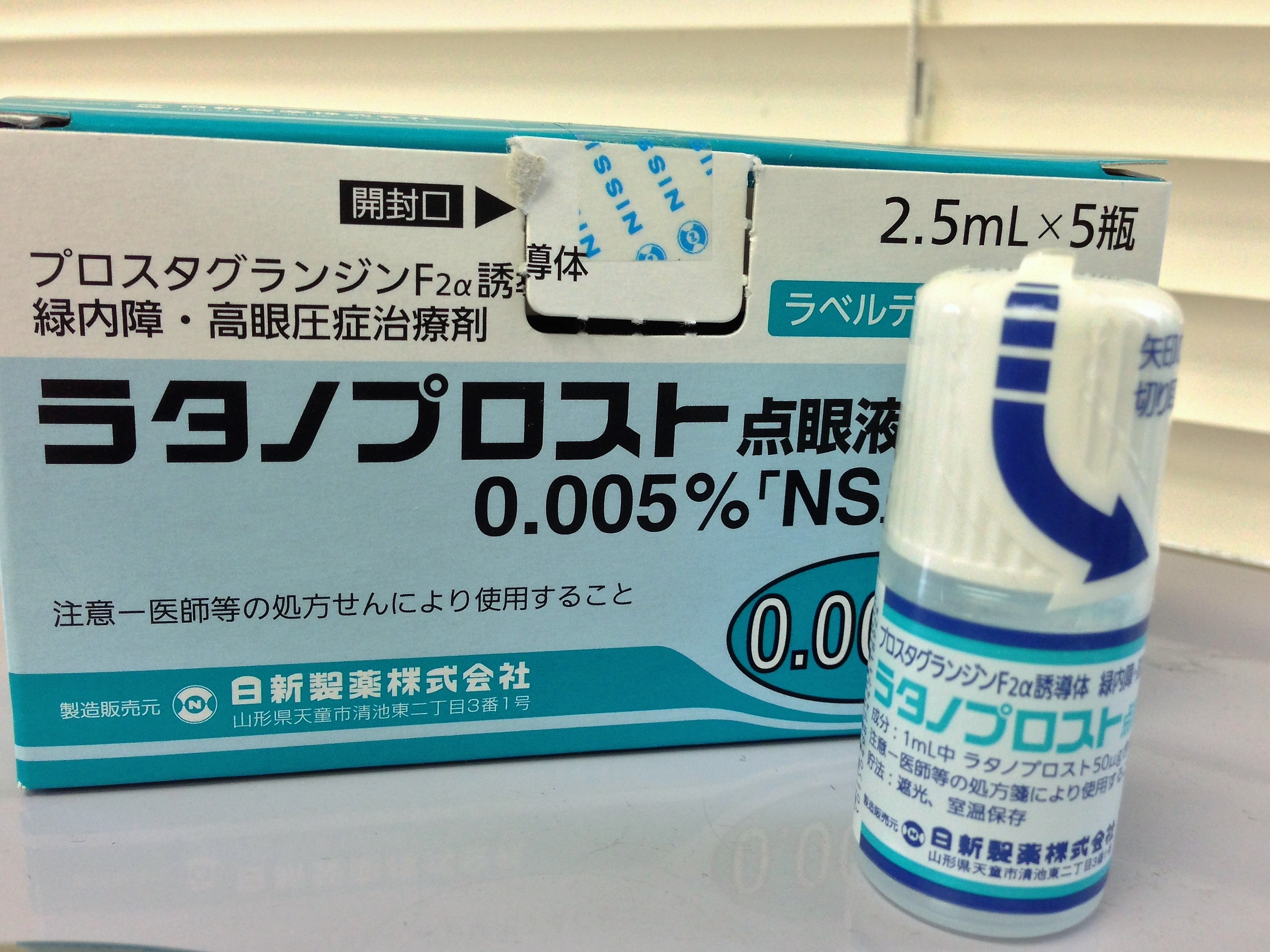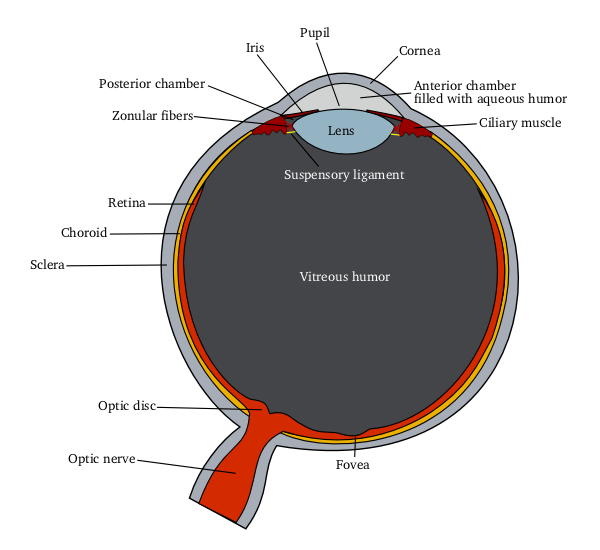|
Xalatan
Latanoprost, sold under the brand name Xalatan among others, is a medication used to treat increased pressure inside the eye (intraocular pressure). This includes ocular hypertension and open-angle glaucoma. Latanaprost is applied as eye drops to the eyes. Onset of effects is usually within four hours, and they last for up to a day. Common side effects include blurry vision, redness of the eye, itchiness, and darkening of the iris. Latanoprost is in the prostaglandin analogue family of medications. It works by increasing the outflow of aqueous fluid from the eyes through the uveoscleral tract. Latanoprost was approved for medical use in the United States and the European Union in 1996. It is on the World Health Organization's List of Essential Medicines. Latanoprost is available as a generic medication. In 2022, it was the 67th most commonly prescribed medication in the United States, with more than 9million prescriptions. It is available as a fixed-dose combination wi ... [...More Info...] [...Related Items...] OR: [Wikipedia] [Google] [Baidu] |
Latanoprost
Latanoprost, sold under the brand name Xalatan among others, is a medication used to treat increased pressure inside the eye (intraocular pressure). This includes ocular hypertension and open-angle glaucoma. Latanaprost is applied as eye drops to the eyes. Onset of effects is usually within four hours, and they last for up to a day. Common side effects include blurry vision, redness of the eye, itchiness, and darkening of the iris. Latanoprost is in the prostaglandin analogue family of medications. It works by increasing the outflow of aqueous fluid from the eyes through the uveoscleral tract. Latanoprost was approved for medical use in the United States and the European Union in 1996. It is on the World Health Organization's List of Essential Medicines. Latanoprost is available as a generic medication. In 2022, it was the 67th most commonly prescribed medication in the United States, with more than 9million prescriptions. It is available as a fixed-dose combinat ... [...More Info...] [...Related Items...] OR: [Wikipedia] [Google] [Baidu] |
Ophthalmic Drug Administration
Ophthalmic drug administration is the administration of a drug to the eyes, most typically as an eye drop formulation. Topical formulations are used to combat a multitude of diseased states of the eye. These states may include bacterial infections, eye injury, glaucoma, and dry eye. However, there are many challenges associated with topical delivery of drugs to the cornea of the eye. Eye drop formulations Two of the largest challenges faced when using topicals to treat pathological states of the eye include Adherence (medicine), patient compliance and ineffective absorbance of drugs into the cornea due to short contact times, solution drainage, tears turnover, and dilution or lacrimation. In fact, researchers in this field of drug delivery agree that less than 7% of drugs delivered to the eye reach and penetrate the corneal barrier, therefore, increasing the frequency of dosing used for topicals. This is one of the fundamental problem associated with using topicals to deliver dr ... [...More Info...] [...Related Items...] OR: [Wikipedia] [Google] [Baidu] |
Netarsudil/latanoprost
Netarsudil/latanoprost, sold under the brand name Rocklatan among others, is a fixed-dose combination medication use to treat elevated intraocular pressure (IOP) in people with open-angle glaucoma or ocular hypertension. It contains netarsudil mesylate and latanoprost. It is applied as eye drops to the eyes. The most common side effects include conjunctival hyperaemia (red eye), pain at the site where the medicine was applied, cornea verticillata (deposits in the cornea, the transparent layer in front of the eye that covers the pupil and iris), pruritus (itching of the eye), erythema (reddening) and discomfort in the eye, increased lacrimation (watery eyes), and conjunctival haemorrhage (bleeding in the surface layer of the eye). Netarsudil/latanoprost was approved for medical use in the United States in March 2019, and in the European Union in January 2021. Medical uses Netarsudil/latanoprost is indicated In medicine, an indication is a valid reason to use a certain te ... [...More Info...] [...Related Items...] OR: [Wikipedia] [Google] [Baidu] |
Erythema
Erythema (, ) is redness of the skin or mucous membranes, caused by hyperemia (increased blood flow) in superficial capillaries. It occurs with any skin injury, infection, or inflammation. Examples of erythema not associated with pathology include nervous blushes. Types * Erythema ab igne * Erythema chronicum migrans * Erythema induratum * Erythema infectiosum (or fifth disease) * Erythema marginatum * Erythema migrans * Erythema multiforme (EM) * Erythema nodosum * Erythema toxicum * Erythema elevatum diutinum * Erythema gyratum repens * Keratolytic winter erythema * Palmar erythema Causes It can be caused by infection, massage, electrical treatment, acne medication, allergies, exercise, solar radiation (sunburn), photosensitization, acute radiation syndrome, mercury toxicity, blister agents, niacin administration, or waxing and tweezing of the hairs—any of which can cause the affected capillaries to dilate, resulting in redness. Erythema is a common ... [...More Info...] [...Related Items...] OR: [Wikipedia] [Google] [Baidu] |
Edema
Edema (American English), also spelled oedema (British English), and also known as fluid retention, swelling, dropsy and hydropsy, is the build-up of fluid in the body's tissue (biology), tissue. Most commonly, the legs or arms are affected. Symptoms may include skin that feels tight, the area feeling heavy, and joint stiffness. Other symptoms depend on the underlying cause. Causes may include Chronic venous insufficiency, venous insufficiency, heart failure, kidney problems, hypoalbuminemia, low protein levels, liver problems, deep vein thrombosis, infections, kwashiorkor, angioedema, certain medications, and lymphedema. It may also occur in immobile patients (stroke, spinal cord injury, aging), or with temporary immobility such as prolonged sitting or standing, and during menstruation or pregnancy. The condition is more concerning if it starts suddenly, or pain or shortness of breath is present. Treatment depends on the underlying cause. If the underlying mechanism involve ... [...More Info...] [...Related Items...] OR: [Wikipedia] [Google] [Baidu] |
Thygeson's Superficial Punctate Keratopathy
Thygeson's superficial punctate keratopathy (TSPK) is a disease of the eyes. The causes of TSPK are not currently known, but details of the disease were first published in the Journal of the American Medical Association in 1950 by American ophthalmologist Phillips Thygeson (1903–2002), after whom it is named. Symptoms and signs A patient with TSPK may complain of blurred vision, dry eyes, a sensation of having a foreign body stuck in the eye, photophobia (sensitivity to bright light), burning sensations and watery eyes. On inspection with a slit lamp, tiny lumps can be found on the cornea of the eye. These lumps can be more easily seen after applying fluorescein or rose Bengal dye eye-drops. The lumps appear to be randomly positioned on the cornea and they may appear and disappear over a period of time (with or without treatment). TSPK may affect one or both eyes. When both eyes are affected, the tiny lumps found on the cornea may differ in number between eyes. The severity of ... [...More Info...] [...Related Items...] OR: [Wikipedia] [Google] [Baidu] |
Heterochromia Iridum
Heterochromia is a variation in coloration most often used to describe color differences of the iris, but can also be applied to color variation of hair or skin. Heterochromia is determined by the production, delivery, and concentration of melanin (a pigment). It may be inherited, or caused by genetic mosaicism, chimerism, disease, or injury. It occurs in humans and certain breeds of domesticated animals. Heterochromia of the eye is called heterochromia iridum (heterochromia between the two eyes) or heterochromia iridis (heterochromia within one eye). It can be complete, sectoral, or central. In complete heterochromia, one iris is a different color from the other. In sectoral heterochromia, part of one iris is a different color from its remainder. In central heterochromia, there is a ring around the pupil or possibly spikes of different colors radiating from the pupil. Though multiple causes have been posited, the scientific consensus is that a lack of genetic diversity is t ... [...More Info...] [...Related Items...] OR: [Wikipedia] [Google] [Baidu] |
Hyperemia
Hyperaemia (also hyperemia) is the increase of blood flow to different tissues in the body. It can have medical implications but is also a regulatory response, allowing change in blood supply to different tissues through vasodilation (widening of blood vessels). Clinically, hyperaemia in tissues manifests as erythema (redness of the skin) because of the engorgement of vessels with oxygenated blood. Hyperaemia can also occur due to a fall in atmospheric pressure outside the body. The term comes . Regulation of blood flow Functional hyperaemia is an increase in blood flow to a tissue due to the presence of metabolites and a change in general conditions. When a tissue increases its activity, there is a well-characterized fall in the partial pressure of oxygen and pH, along with an increase in partial pressure of carbon dioxide, and a rise in temperature and the concentration of potassium ions. The mechanisms of vasodilation are predominantly local metabolites and myogenic eff ... [...More Info...] [...Related Items...] OR: [Wikipedia] [Google] [Baidu] |
Iris (anatomy)
The iris (: irides or irises) is a thin, annular structure in the eye in most mammals and birds that is responsible for controlling the diameter and size of the pupil, and thus the amount of light reaching the retina. In optical terms, the pupil is the eye's aperture, while the iris is the diaphragm (optics), diaphragm. Eye color is defined by the iris. Etymology The word "iris" is derived from the Greek word for "rainbow", also Iris (mythology), its goddess plus messenger of the gods in the ''Iliad'', because of the many eye color, colours of this eye part. Structure The iris consists of two layers: the front pigmented Wikt:fibrovascular, fibrovascular layer known as a stroma of iris, stroma and, behind the stroma, pigmented epithelial cells. The stroma is connected to a sphincter muscle (sphincter pupillae), which contracts the pupil in a circular motion, and a set of dilator muscles (dilator pupillae), which pull the iris radially to enlarge the pupil, pulling it in folds. ... [...More Info...] [...Related Items...] OR: [Wikipedia] [Google] [Baidu] |
Meta-analysis
Meta-analysis is a method of synthesis of quantitative data from multiple independent studies addressing a common research question. An important part of this method involves computing a combined effect size across all of the studies. As such, this statistical approach involves extracting effect sizes and variance measures from various studies. By combining these effect sizes the statistical power is improved and can resolve uncertainties or discrepancies found in individual studies. Meta-analyses are integral in supporting research grant proposals, shaping treatment guidelines, and influencing health policies. They are also pivotal in summarizing existing research to guide future studies, thereby cementing their role as a fundamental methodology in metascience. Meta-analyses are often, but not always, important components of a systematic review. History The term "meta-analysis" was coined in 1976 by the statistician Gene V. Glass, Gene Glass, who stated ''"Meta-analysis refers t ... [...More Info...] [...Related Items...] OR: [Wikipedia] [Google] [Baidu] |
Millimeter Of Mercury
A millimetre of mercury is a manometric unit of pressure, formerly defined as the extra pressure generated by a column of mercury one millimetre high. Currently, it is defined as exactly , or approximately 1 torr = atmosphere = pascals.Council Directive 80/181/EEC of 20 December 1979 on the approximation of the laws of the Member States relating to units of measurement and on the repeal of Directive 71/354/EEC of the It is denoted mmHg or mm Hg. ... [...More Info...] [...Related Items...] OR: [Wikipedia] [Google] [Baidu] |
Pfizer XalaTAN Latanoprost Eye Drops
Pfizer Inc. ( ) is an American multinational pharmaceutical and biotechnology corporation headquartered at The Spiral in Manhattan, New York City. Founded in 1849 in New York by German entrepreneurs Charles Pfizer (1824–1906) and Charles F. Erhart (1821–1891), Pfizer is one of the oldest pharmaceutical companies in North America. Pfizer develops and produces medicines and vaccines for immunology, oncology, cardiology, endocrinology, and neurology. The company's largest products by sales are the Pfizer–BioNTech COVID-19 vaccine ($11 billion in 2023 revenues), apixaban ($6 billion in 2023 revenues), a pneumococcal conjugate vaccine ($6 billion in 2023 revenues), palbociclib ($4 billion in 2023 revenues), and tafamidis ($3 billion in 2023 revenues). In 2023, 46% of the company's revenues came from the United States, 6% came from Japan, and 48% came from other countries. Pfizer has been a publicly traded company for nearly a century, making its debut on the New York Stoc ... [...More Info...] [...Related Items...] OR: [Wikipedia] [Google] [Baidu] |





